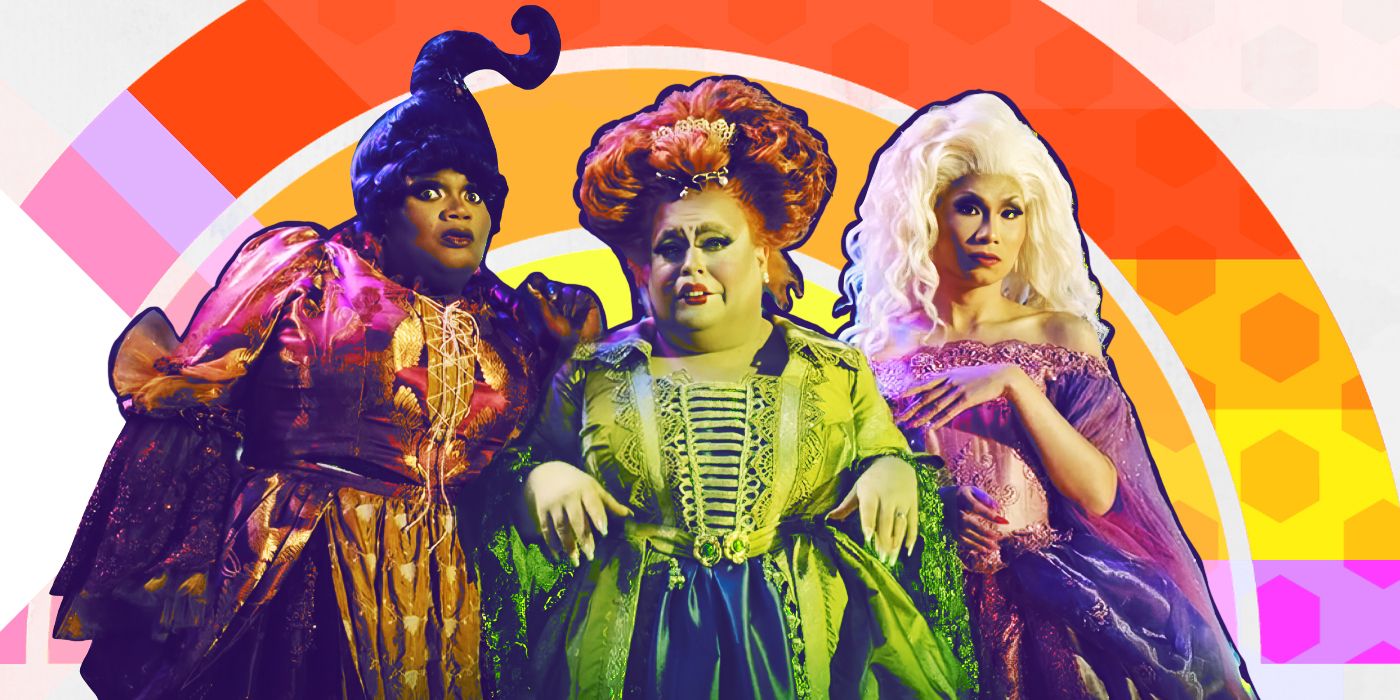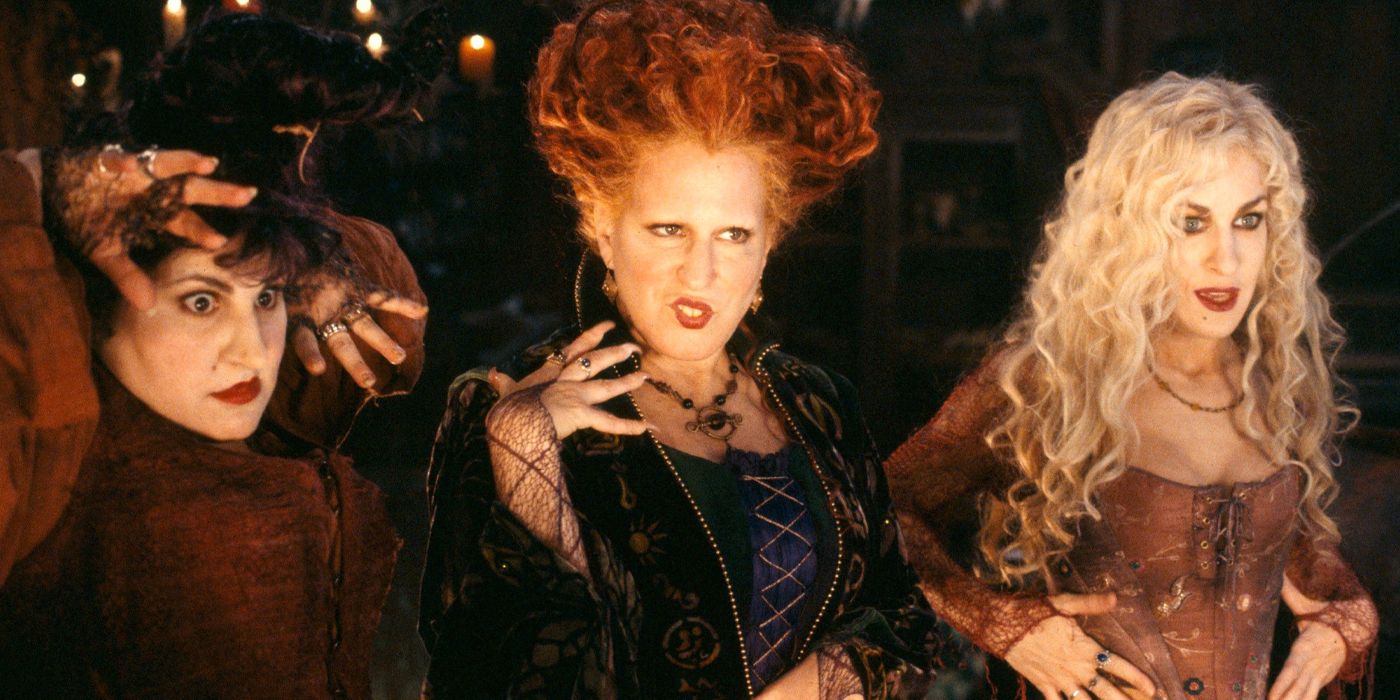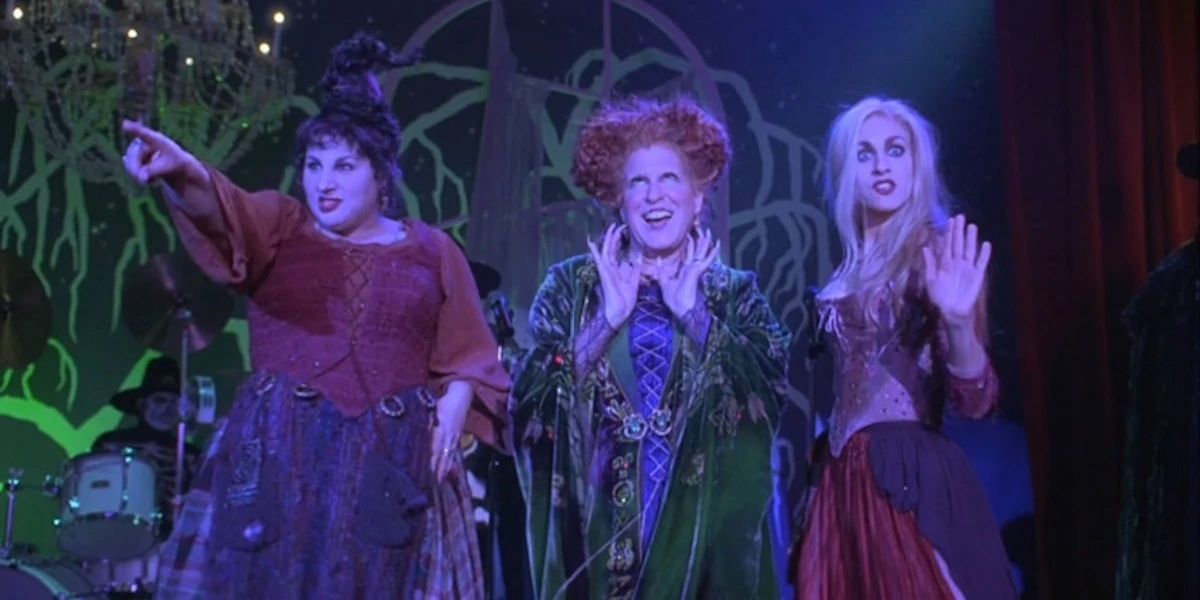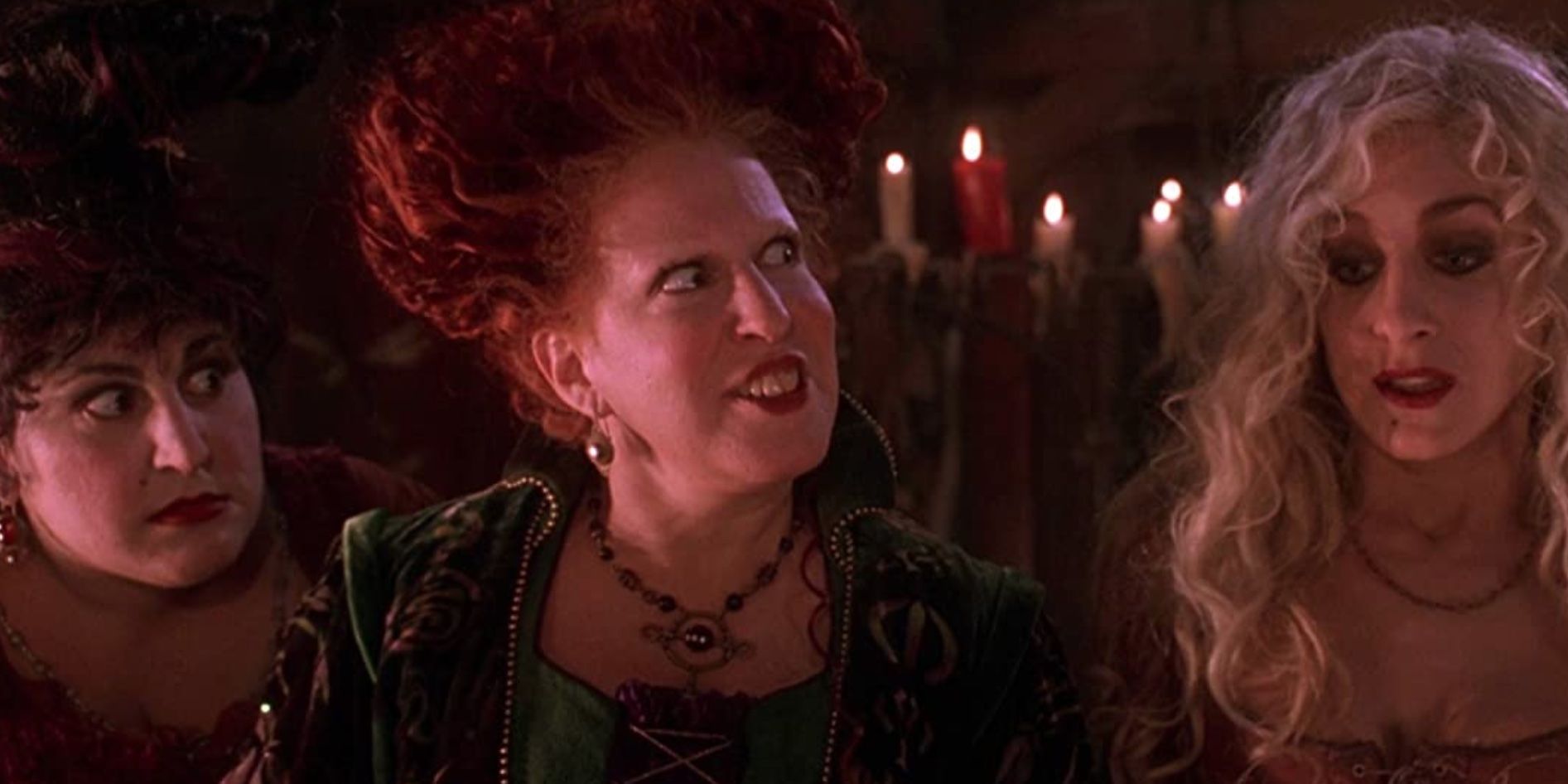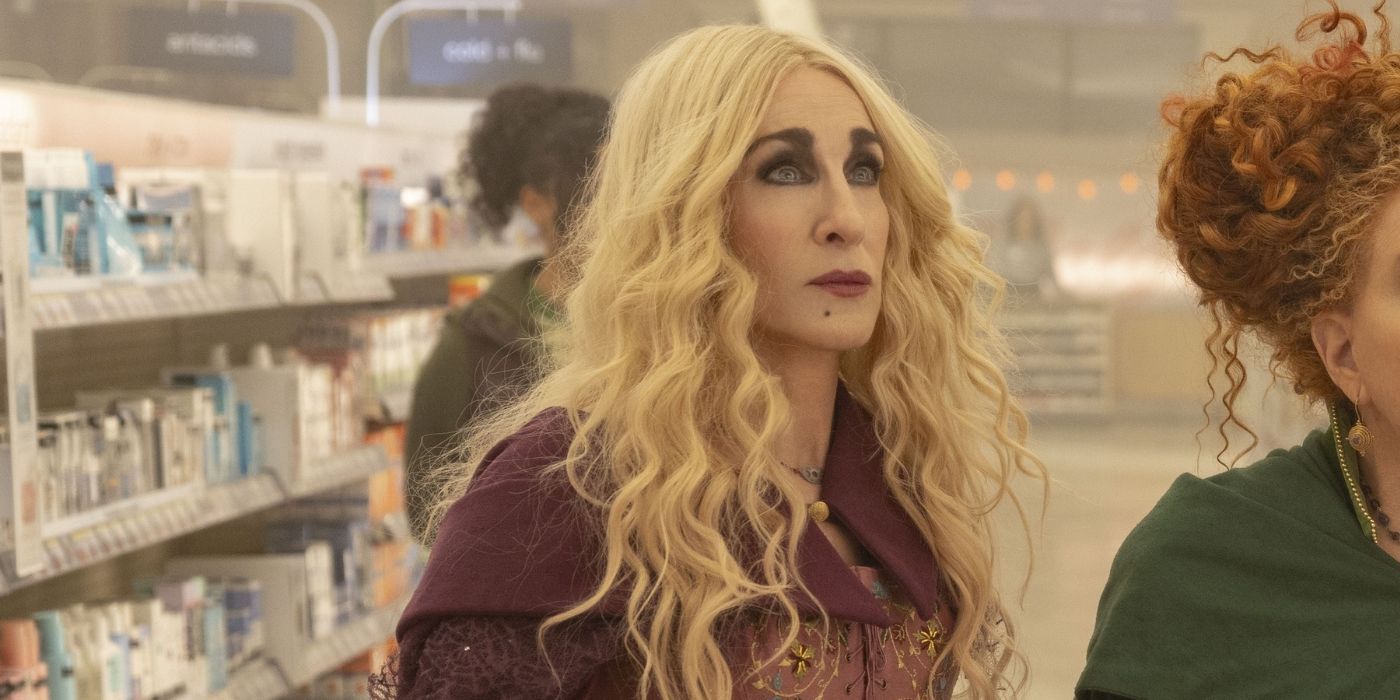Since its release nearly 30 years ago, Hocus Pocus only continues to grow in popularity. With Hocus Pocus 2 now streaming on Disney+, it’s clear that the Sanderson sisters, Winnie (Bette Midler), Sarah (Sarah Jessica Parker), and Mary (Kathy Najimy), aren’t going anywhere anytime soon. Though nearly everyone makes Hocus Pocus a part of their annual spooky season viewing, no one gags as hard for the film’s trio of villains quite like the gays. But just what is it about these famous sisters that makes them the definitive queens of Halloween for gay fans?
The Campy Characterization of the Sanderson Sisters
First, the characterization of the Sandersons, and the performances that bring them to life, are undeniably campy. The camp sensibility, though sometimes attributed to various popular culture artifacts, is a specifically queer aesthetic traced to gay men’s relationship with classical Hollywood cinema. Drawing on the theatrics of exaggeration, camp is stylized over-the-top-ness, often expressed through performative, witty artifice. To call the Sanderson sisters campy, then, is to attribute their appeal to gay fans, in part, to their larger-than-life qualities.
As with many classic camp characters, the Sanderson sisters’ costume, make-up, and hair are one of the most apparent expressions of their over-the-top-ness. Each sister is dressed in a 1600s gown and cloak that makes them stand out in distinction to the other contemporarily costumed characters. Though they are dressed this way for narrative purposes (the Sandersons are revived after 300 years), the costumes are campy not only because they are differentiating, but also because they are modernized silhouettes that allow them to look both historical and fashionable. Also significant is how each character’s garments express their unique personalities. Winnie’s greens, purples, and heavy fabrics express her supreme vileness and royal position among the sisters. Mary’s contrasting reds and plaid apron-like skirt indicate her difference from and subservience to Winnie. Sarah’s low-cut corset, made of muted pinks and reds, articulates her confused, lustful femininity. Paired with their costumes are unique hairstyles and make-up that compliment the qualities expressed by their costume design. The most iconic of the three being Winnie’s bunched, vivid red bouffant and heart-shaped lipstick. Impractical and incongruous with the logic of the movie (at no point do the witches ever style themselves), their costumes, make-up, and hair allow the camp sensibility to shine through.
Delightfully Fantastical
Some of the characters’ most distinctive traits also demonstrate their campiness, aided by the exaggerated acting styles of their performers. Rather than imbuing their characters with “realism,” each sister is delightfully fantastical. Mary’s cautious nature and fear of Winnie’s wrath manifests itself in a crooked lip that Najimy manages to contort for comedic effect throughout the film. Sarah’s hyperactive liveliness is rendered through screams and frenzied movements. Parker’s committed exuberance infuses the performance with a childlike whimsy. Winnie’s calculatedness appears in her shifting poses and twirling hand gestures. Additionally, Midler brings her talent for comedic delivery to Winnie’s bitter wit, famously exemplified by her pause and punctuation of the line, “Oh look, another glorious morning…makes me sick!”
There is no effort to ground these characters in any sort of authenticity, which is what makes them so wonderfully fantastic, even in a fantasy film.
Of course, the campiest scene in the film, and therefore the one that most exemplifies the Sandersons’ gay appeal, is Winnie’s “I Put a Spell on You” musical number. Simply the presence of a musical number in an otherwise non-musical film is enough to count as camp (the musical genre is often the campiest), but the sequence dials the camp up through its delightfully illogical manifestation. The performance features a song that Winnie somehow knows perfectly, has updated lyrics to address their revival, is perfectly suited for the instruments present on stage, requires an unrehearsed set of backing vocals from Sarah and Mary that they execute flawlessly, and that is danced in-sync without any pre-performance choreography. The lack of narrative logic is irrelevant for the story, though, as it truly just exists to support the spectacle of these campy characters.
Actresses Who Are Advocates, Too
It is impossible to discuss the camp appeal of “I Put a Spell on You” without addressing the extratextual resonance for gay fans found in watching Midler sing and dance. This introduces the second reason for the film’s popularity among gay audiences: the actresses who embody the Sanderson sisters are embedded in gay pop culture. Midler famously achieved gay icon status after she built a following singing in gay bathhouses. Transitioning to being an all-around talent of stage and screen, Midler has starred in several gay favorites (Beaches remains a particularly beloved example) and remains an advocate for the community. Parker has portrayed one of the most celebrated characters of the gay pop culture canon, Carrie Bradshaw, in the various iterations of Sex and the City, including in the recent sequel series And Just Like That… Najimy has found gay fans throughout her career, as well, from her performances in the Sister Act films to the recent gay holiday movie Single All the Way. The actresses’ recurrence in gay-appreciated or centric content makes them enduringly popular as stars for gay people, thus also making some of their most famous characters enduringly popular.
On the Margins of Society
Third, from an analytical perspective, it is no surprise that gay viewers identify with and find joy in characters who live on the margins of society. Living in a cottage literally removed from the community, the Sandersons exist apart from the rest of the world. Creating family in an alternate kinship formation (three sisters who intend to live together eternally) with a particular disdain for traditional family structure (evidencing by their eating of children’s souls), the Sandersons’ lives are textually resonant with those of certain gay viewers. Rather than identifying with the film’s protagonists, gay audience members are far more likely to root for the film’s villains, whose lives may echo their lived experiences.
Considering their campy characterization, the gay appreciation for the actresses who portray them, and their potential for empathetic identification, it is no wonder that the Sanderson sisters endure as gay icons. For perhaps the best evidence of the taking up of the Sandersons in the gay world, one need look no further than their presence in drag culture. Every Halloween season is sure to see Winnies, Sarahs, Marys, and more Winnies at the local drag brunch. The popularity of the Sandersons as drag inspiration is so widespread that Hocus Pocus 2 even features popular queens Ginger Minj, Kahmora Hall, and Kornbread as Sanderson sister impersonators within the film.
Even the author of this piece himself, a certified gay™, has donned a red bouffant and heart-shaped lip to get into the Halloween spirit. It is often said that Halloween is the gay-equivalent to Christmas. If that’s the case, the Sanderson sisters, campy gay icons portrayed by gay icons, are the gay equivalent to Santa Claus.

